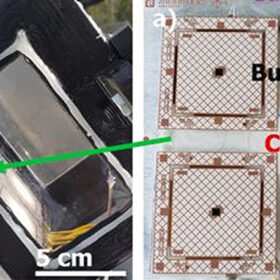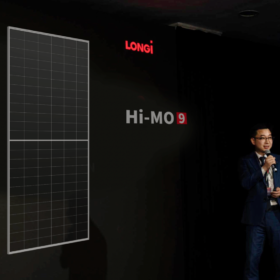List of top solar module manufacturers led by JA Solar, Trina Solar, Jinko Solar
Wood Mackenzie says that JA Solar has taken first place on its list of solar panel manufacturers. Nine of the first 12 positions are held by Chinese manufacturers, seven of them could surpass 100 GW of capacity by 2027, and eight are self-sufficient in cell capacity, according to the research firm.
Concentrator photovoltaic module based on surface mount technology
A research group in Canada has optimized the performance of concentrator photovoltaics by using the so-called surface-mount technology for thermal management. The CPV module prototype utilizes four non-interconnected III-V germanium cells, a Fresnel lens, and a transparent glass printed-circuit board.
Longi presents 24.4%-efficient 660 W HPBC solar panel
Intended for applications in utility-scale PV projects, the new Hi-MO 9 module is available in eight versions with power output ranging from 625 W to 660 W and power conversion efficiency spanning from 23.1% to 24.4%.
Bosch unveils water source heat pumps for residential, commercial applications
Bosch Home Comfort has presented two new heat pumps series that can be used for both retrofits and new buildings. Both products have a size of a size of ½ to 6 tons and a coefficient of performance of up to 4.9.
JinkoSolar claims 33.24% efficiency for perovskite-silicon tandem solar cells
JinkoSolar says it has achieved a 33.24% efficiency rating for its perovskite-silicon tandem solar cells, confirmed by the Shanghai Institute of Microsystem and Information Technology under the Chinese Academy of Sciences (CAS).
TCL Zhonghuan reveals plans to acquire majority stake in Maxeon
Chinese wafer manufacturer TCL Zhonghuan says it wants to invest around $197.5 million to increase its stake in Maxeon from 22.39% to at least 50.1%. A Maxeon spokesperson told pv magazine that the plan would place the company in a solid financial position.
Sharp unveils new TOPCon solar modules
The Japanese electronics manufacturer has launched the NU-JC440 and NU-JC430B panels with efficiencies of 22.53% and 22.02%, respectively. Both products are IEC/EN61215 and IEC/EN61730-certified and rely on M10 wafers.
U.S. scientists develop air-bridge thermophotovoltaic cells with 44% efficiency
U.S. scientists have developed a thermophotovoltaic cell that could be paired with inexpensive thermal storage to provide power on demand. The indium gallium arsenide (InGaAs) thermophotovoltaic cell absorbs most of the in-band radiation to generate electricity, while serving as a nearly perfect mirror.
Research shows repaired PV modules can perform with acceptable losses
A research group has demonstrated the technical feasibility of using repaired solar modules with satisfying results. It also warned, however, that there is an urgent need to define a protocol for evaluating the features of a “viable” repaired panel.
Researchers demonstrate 25%-efficient perovskite-cadmium tandem solar cell
University of Toledo researchers say the cell has a top perovskite cell with a transparent back contact made of indium zinc oxide and a commercially established cadmium telluride bottom device. They claim the champion tandem cell has the potential to reach a 30% efficiency.
















